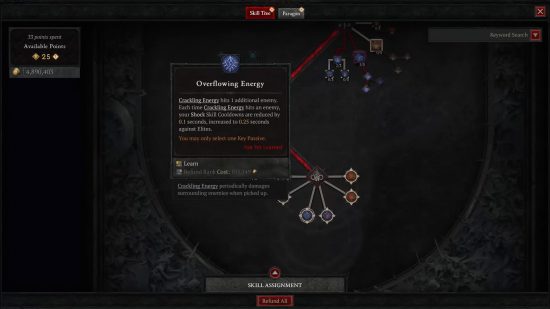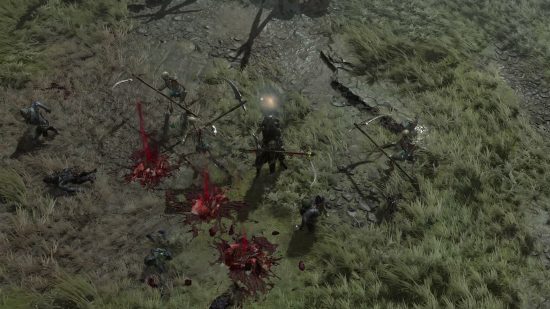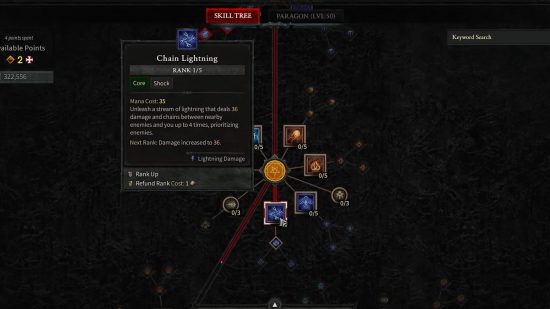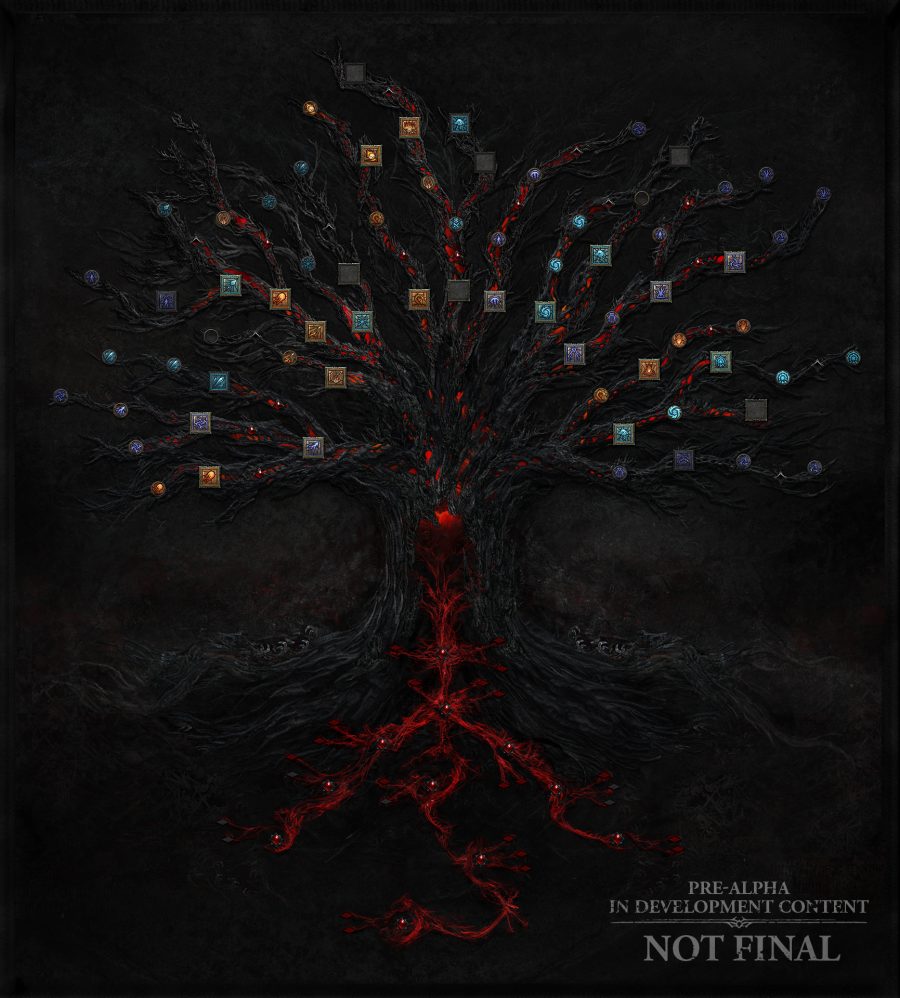Wondering how the Diablo 4 skill tree works? The Diablo 4 release date is getting closer, so you may want to learn more about how the class skill trees will work when the dungeon crawling role playing game finally arrives.
To make the most out of the skill tree system, you can follow our Diablo 4 classes guide, where we’ve dug deep to help you decide the best class to play. Although the options of abilities you find for each of them are fixed, new additions to the game are going to be constantly made in order to revitalize the players’ experience and balance the builds, according to Blizzard’s dev update blog.
Blizzard is “currently aiming for 30-40% of the nodes filled in for endgame, so that players can have very distinct, and different ways they build out their character.” It looks like we can expect an increased emphasis on choosing particular skill branches to explore when customising our character, in contrast to building characters around powerful items and equipment. Here’s how the skill tree will work in Diablo 4.
Diablo 4 skill tree explained
The Diablo 4 skill tree is a system you must use to unlock the active and passive abilities available for your character.
They are a fundamental part of your experience with the game, since it’s the system used to help your character play the way you want it to. While each class is different, without a skill tree, there would be only one way of playing as a Barbarian or a Druid for example. In Diablo 4, other aspects of the game, such as pieces of equipment, work around the skills you pick, enhancing or synergizing them.
The skill tree works as a path you must go through to access new and more powerful skills, representing your character’s development. This path is made of nodes of skills that must be unlocked by spending skill points in the already available abilities. While each class has specific trees related to their kits, all five classes have a basic node, a core node, a defensive node, and an ultimate node. Each of these nodes groups skills that share the same function – main damage source, defensive skills for instance – but with different mechanics and properties.

Although some changes have been applied to each class in the game after the last open beta, as indicated in an official Diablo 4 blog, the classes’ skill trees haven’t changed and each of them brings different possibilities when it comes to gameplay.
Barbarian: With skills that have the potential to taunt enemies and use their attacks against them, the Barbarian has a kit for those who would like to use different weapons. Sorceress: The Sorceress has a good variety of elemental skills that can synergize quite well to deal great single-target or area-of-effect damage. Druid: Compared to other kits, the Druid skill tree is one of the most versatile among the game’s roster of characters, since it allows you to focus on damage as well as utility. Rogue: Focused on fast-paced, long, and mid-range combat, the Rogue comes with a skill tree filled with combos and abilities that boosts their damage, such as poisons and traps. Necromancer: This class’s skill tree comes not only with the abilities that allow you to summon powerful corpses to fight for you but also to deal a good amount of direct damage.
In every node you’ll find active skills and passive skills that are represented as a square and a circle respectively. To unlock both types of skills, you must spend at least one skill point on them. After that, you can spend more points in order to increase their ranks, making them more powerful.
Active skills are the ones you use during a fight or as you walk with your character around the map. They must be equipped in your bar and they can also be improved a maximum of five times each.
Another important characteristic of these skills is that they are tied to specific types of weapons. For instance, the Barbarian skill Hammer of the Ancients requires a two-handed bludgeoning weapon equipped to be used. Because of that, depending on the builds you’re running, you may need to carry more than one different weapon in the bag. Passive skills aren’t required to be equipped, since it comes into effect automatically once they are unlocked.
Every active skill has one enhancement and two upgrades each. While both are represented with small lozenges connected to the square skill, the former only increases the effects of the skill, and the latter may also change its mechanics. After a skill is unlocked in a node, your next skill point can be spent unlocking its enhancement, and then you can pick one of the upgrades. Only one upgrade can be chosen per skill.

According to a recent stream from Diablo 4 developer, Blizzard, the skill tree allows players to go through all of the skills using a search bar and utilises a tag system so that you can analyze all possible interactions to create the strongest builds.
How to earn skill points in Diablo 4
In Diablo 4, you can have a total of 63 skill points. Because progressing through the skill tree demands skill points to unlock new nodes, you must focus on earning them to prepare your character for the Diablo 4 endgame. There are two sources of skill points in the game. The first one is through levelling. Whenever you level your character up, you earn one skill point. In Diablo 4, although a character’s level cap is 100, you stop earning skill points after level 50.
The second method, and the one you need to do in order to get the remaining skill points, is completing side content in the game’s regions. By exploring the maps you earn points in the Renown system which rewards you with some skill points. Although some rewards from the Renown system are shared among characters, others, such as skill points, are not. You need to complete it, at least to some extent, with all of your characters.

Diablo 4 respec
Will you be able to respec your skills in Diablo 4?
Yes – an unlimited number of times, but it won’t be free.
In Diablo 4’s December 2020 quarterly update, Blizzard explained that it wants to encourage experimentation, so initially, respeccing is easy – but as your character develops, the cost of respeccing will similarly increase, eventually requiring a “significant investment” – the nature of which is currently unknown, but we imagine there will be a substantial resource cost.
Diablo 4 allows you to respec skills from level two, once you unlock your first ability. To do so, you just need to open the skill tree and right-click the skill you want to have the points spent back. For each refund, you pay a quantity of gold. There is also the option of using the “refund all” option at the lower part of the screen which will reset all skills, ranks, enhancements, and upgrades. Since resetting a full build every time you have to face a different boss or go from PvE to PvP might become quite expensive, respeccing is not something you should do carelessly.
That’s everything we know about the Diablo 4 skill tree so far as well as how to earn skill points and respeccing your character. If you’re still wondering whether you should jump into the pits of hell to kill legions of demons, be sure to check our Diablo 4 gameplay preview. You might also want to know more about the battle pass, to better understand how it affects the overall experience with the game.



















 English (United States) ·
English (United States) ·